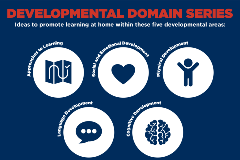- 877.624.2602
- Schedule a Tour
 This month, let’s take a closer look at the Cognitive Development Domain, focusing on creative arts expression.
This month, let’s take a closer look at the Cognitive Development Domain, focusing on creative arts expression.
Cognitive development involves how children think, explore and figure things out. It refers to things like memory and the ability to learn new information. This domain includes the development of knowledge and skills in math, science, social studies, and creative arts.
Creative arts is about creative thinking. Allowing children the opportunity to express themselves through creativity is beneficial to many areas of their development. Children become less fearful, learn that there can be many solutions to any given problem, and develop fine motor and communication skills. Because of this, we integrate opportunities for creative arts expression into all areas of the school day.
You can encourage creative arts expression at home.
Infants:
- Listen to music and sing with your baby.
- Provide your infant with child-safe paint and allow them to paint with their hands. Display their work where they can see it.
- Allow your child to experiment with using different objects to make sounds. This could be musical toys or household objects—a pot and wooden spoon can be a wonderful drum!
Toddlers/Twos:
- Play your child’s favorite music and dance with them.
- Go outside, collect objects such as leaves, sticks, flowers, grass, etc., and make a collage with your child.
- Provide materials (for example, dress-up clothes, purses, briefcases, hats, etc.) for your child to use in dramatic play.
Preschool/Pre-K:
- Ask your child to explain a piece of artwork they have created. Ask why they chose certain colors and shapes and what the piece is meant to represent.
- Point out different musical instruments when you see them in books or when you hear them in a song. Help your child to make associations between instruments and the sounds they make.
- Create stories with your child and act them out together. You can be the actors in the dramatization or you can use puppets.
School Age:
- Introduce your child to different genres of music. Ask them about the differences they hear between genres. Also, ask what their favorite genre is and why.
- Dance to different genres of music with your child. See how they change their movements between genres and ask why they did this.
- Provide opportunities for your child to draw. If possible, have a space for them with paper, pencils, crayons, and markers.
Here are some great resources about how to support creative arts expression at home:
https://www.naeyc.org/our-work/families/10-ways-babies-learn-sing-to-them
https://www.naeyc.org/our-work/families/supporting-development-creativity
